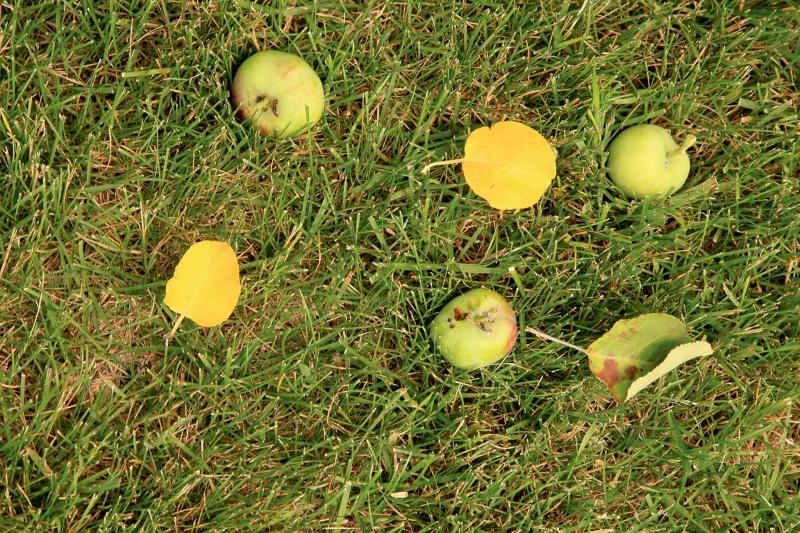Last week we discussed a number of issues that are causing problems for apple trees. This article will continue with other issues faced by declining apple trees.
Apple scab is a fungal disease that occurs mostly on ornamental crab apple trees but can infect apple trees as well. Apple scab first appears on the undersides of young leaves in the spring as they open up and become targets for infection. The infected leaves become yellow or orange-yellow as they die, and then fall from the tree. The dropping of these premature coloured leaves is an important symptom of apple scab disease. Disease spots will show up on the leaves. The disease rarely infects the fruit in Manitoba, but it does further south in the United States. Yellow leaves are actively dropping at the time of this writing.
This disease can be controlled with the use of approved copper sulfate fungicide sprays, but these will need to be reapplied after periods of frequent rainfall. At least two applications will be necessary during the summer. The treatment will need to be repeated next year as well. Leaving disease leaves around on the ground will result in a re-infection of the tree the following spring. All leaves, twigs and fruit must therefore be collected before winter and properly disposed.
I have written extensively about fire blight disease, however, I continue to find most owners of apple trees are not aware of the signs of this disease. Early signs of this bacterial disease include infected flowers that have a brownish shriveled appearance, shriveled leaves that turn a medium brown (often cinnamon coloured in apple trees), or curled ends of twigs with a dark brown or black (pear especially) colour. Often the inside of the bark will be discoloured reddish brown when the bark is peeled back on some trees. This is a lethal tree disease and action on this must be taken right away if you want to try to get the disease under control. The disease is often transmitted by bees and wasps in the spring.
Pruning off the infected parts at least 30 centimetres away from the infected location is very important. Use sharp pruning tools and always disinfect the tools with bleach and water, or methyl hydrate or with denatured alcohol after each cut. If this is not done the disease will spread with the continued use of pruning tools. Do not leave any pruned twigs or branches in the yard as the disease will emerge in the following year to re-infect the tree. Further information about this disease and illustrations are found in my new book, Dr. Tree's Guide to the Common Diseases of Urban Prairie Trees. However, the best time to prune healthy deciduous (leaf shedding) trees such as fruit trees is normally in October or November or in late March to early April. Copper sulfate fungicide should be sprayed on the infected tree three times, ideally from mid-late May to July, about 10 days to two weeks apart. Infected trees should be fertilized either in the spring or fall to provide nutrient energy to help repair disease damages.
Apple fruit is often attacked by the apple maggot fly. The female fly lays eggs on the newly developing fruit in June. The eggs develop into maggot larvae (grubs) which bore into the fruit leaving mushy brown trails inside the fruit. Feeding by the maggots causes the apples to fall.
The best way to control apple fly maggots is to trick them by using red, sphere like Christmas ornaments. Match the size of the ornament to the size of the fruit. Connect a good length of stiff (but partly flexible) wire to each ornament. Then, apply sticky Tanglefoot to at least five to seven red Christmas ball ornaments (nylon or plastic ones work well). Larger trees will likely need more ornaments. Sprinkle the Tanglefoot with apple cider powder or any fruit crystal essence. Begin the process once you see new fruit on the tree later in spring usually about mid-June. Keep Tanglefoot away from your clothes and off your fingers. The sticky substance will destroy clothes. Carefully hang the balls from open branches such that if they were to move in the wind they would not make contact with other branches or leaves. Concentrate more of the ornaments on the south side of the tree which is favoured by the flies. Check them frequently, clean the balls of insects, and re-apply Tanglefoot. You will probably have to do this every two to three weeks. It will not be practical to save the sticky balls for next year; so keep a supply of the red ornaments for future use.
When the fruit falls to the ground the maggots leave the fruit and burrow about five centimetres into the ground. In the soil, the maggots molt and become pupae. In the following spring the pupae change into adult flies, and the flies emerge from the ground in mid-June to early July. The growth cycle of the apple maggot is then repeated. That is why one should never let infested apples rot on the ground as the maggots do crawl out of the fruit. Those fallen apples also attract wasps. Always collect fallen apples early and dispose of them in the trash or thoroughly mix them in the compost.
Michael Allen M.Sc.F., RPF (ret'd) is a consulting urban forester, tree diagnostician and certified arborist. He owns Viburnum Tree Experts. He can be reached at 204-831-6503 or 204-223-7709.




